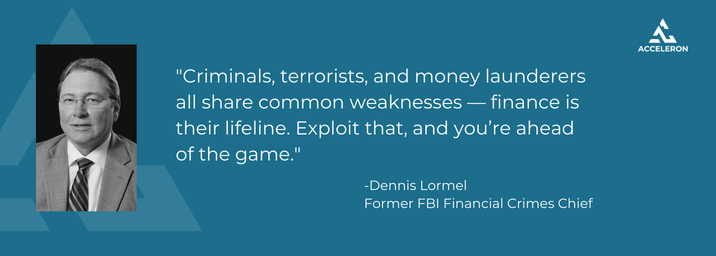The Year in Cross-Border Payments and Correspondent Banking
International wire automation, stablecoins, wallets, and AI reshape global money movement What a pivotal year in cross-border payments. No one...
4 min read
 Daisy Lin, Head of Marketing, Acceleron
:
1/15/25 9:02 AM
Daisy Lin, Head of Marketing, Acceleron
:
1/15/25 9:02 AM

It was the morning of September 11, 2001, and Dennis Lormel was at FBI headquarters, where he served as the Chief of the Financial Crimes Program. Like the rest of the nation, he watched in stunned disbelief as the events of that day unfolded. But unlike most, Lormel knew his role in the response would be critical. Drawing from his decades of experience, he immediately began to investigate how terrorists might have exploited the financial system to fund their heinous acts. Within 24 hours, Lormel had drafted a comprehensive investigative plan to trace the money trail, an effort that would soon uncover vital links and set a new standard for financial crime investigations. This interview explores Lormel’s journey from that pivotal day to offering modern strategies for banks to combat financial criminals and money launderers. Lormel, who also serves on the Acceleron Board of Directors, provides a roadmap for detecting and defeating bad actors who exploit the financial system.
During his 28-year tenure at the FBI, Lormel supervised financial crime squads, initiated the first financial crimes task force in New York City, and authored proposals for undercover operations, including the longest continuous-running undercover operation in FBI history. His expertise lies in exploiting the vulnerabilities of criminals, including their reliance on the financial system.
"Criminals, terrorists, and money launderers all share common weaknesses — finance is their lifeline. Exploit that, and you’re ahead of the game," Lormel explains.

After 9/11, Lormel led the FBI’s financial investigation team. Under his leadership, the FBI centralized efforts to map the flow of funds used in the attacks. Investigators put together detailed profiles of the 19 hijackers, tracking their financial activities to uncover patterns and connections. They traced $328,000 in funding through 18-20 banks that directly supported the attacks.
He shares how FBI Director Robert Mueller’s decision to centralize multiple investigations became the key to connecting the dots and uncovering the full scope of the terrorist financing network:

This work not only confirmed al-Qaeda’s funding but also identified individuals who could have been involved in a second wave of attacks. This groundbreaking work exposed the vulnerabilities in the financial system and set the standard for leveraging financial intelligence to combat terrorism.
Key lessons from this investigation include:
According to Lormel, criminals, terrorists, and money launderers share common vulnerabilities that can be exploited by law enforcement and financial institutions. These include:
Lormel emphasizes that financial institutions are repositories of invaluable intelligence. By monitoring transactions for anomalies, banks and credit unions can identify red flags, such as unusual activity that doesn’t align with a customer’s profile. “The bad guys have to expose themselves to use the financial system,” he says. “That’s their vulnerability.”
After leaving the FBI, Lormel transitioned into consulting for financial institutions and educating professionals on combating financial crime. Through his work with ACAMS (Association of Certified Anti-Money Laundering Specialists), he conducts anti-money laundering training and practical strategies to outmaneuver bad actors. Additionally, as a member of the Acceleron Board of Directors, he helps guide the company in fostering robust financial crime prevention strategies and innovative solutions for the banking sector.
Here are some of his actionable strategies for community banks and credit unions to mitigate risks and enhance their anti-money laundering (AML) efforts:

Financial institutions play a dual role as both facilitation tools and detection mechanisms. Community banks and credit unions can disrupt money laundering and illicit activities by understanding their customers, monitoring transactions for anomalies, and maintaining transparency. “The more transparent the situation,” Lormel notes, “the less likely you’re dealing with financial crime.”
For smaller institutions with limited resources, partnerships with technology providers offer a cost-effective way to manage risks and stay ahead of bad actors. “You don’t need a large team,” Lormel says. “You just need the right tools and a practical approach.”
These insights underscore the importance of vigilance, partnerships, and practical solutions in combating financial crime. Whether it’s following the money in a post-9/11 investigation or leveraging technology to detect anomalies, the strategies he advocates are as relevant today as ever.
“At the end of the day, it’s about staying one step ahead of the bad guys,” Lormel says. “By understanding their weaknesses and leveraging our strengths, financial institutions can protect the system and their customers from harm.”
Acceleron builds patented software that allows community banks and credit unions to conduct international payment transactions profitably through a correspondent banking marketplace. Serving over 200 financial institutions and facilitating more than $1 billion in international payments annually, Acceleron helps small banks generate non-interest income and compete more effectively with high-fee big banks. Our solutions integrate seamlessly with top payments platforms, ensuring quick implementation and smooth operation.
Subscribe to our monthly newsletter, "The Exchange," to stay ahead of the curve and get original content you won't find anywhere else!

International wire automation, stablecoins, wallets, and AI reshape global money movement What a pivotal year in cross-border payments. No one...

New rules, no pennies, and next-generation rails: this month’s biggest banking news As the year winds down, the industry isn’t slowing. The Fed is...

The SVP, Head of Business Development for Service Providers at The Clearing House talks instant payments, bourbon, and fraud. When you talk to...